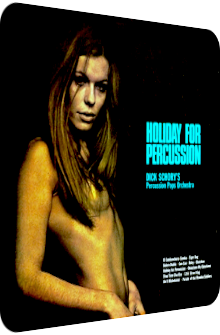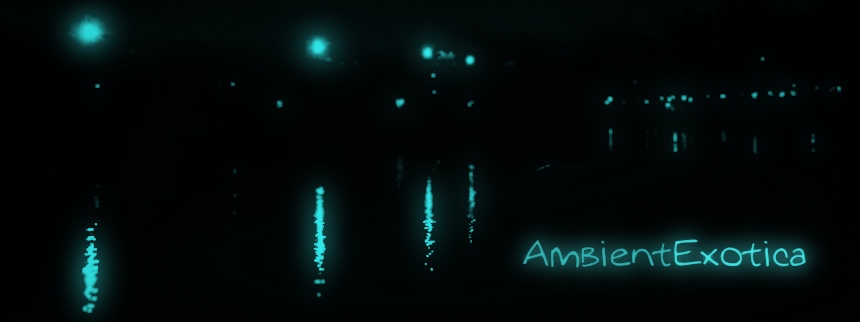
Dick Schory
Holiday For Percussion
1962
The yearning for a great holiday keeps a modern society alive and fully intact, right? The 50's and 60's brought us many different holiday-related albums, some of them successful travelogs drawing from the habits and traditions of many countries, others being more fond of the general perception of escapism and the feeling of carefreeness rather than a time-compressed fleeting visit through several destinations. In 1962, percussionist Dick Schory (born 1931) sees the market-related opportunity of the ongoing vacation movement and decides (or is – ahem – pushed) to come up with a big band album of nine renditions and three original cuts, called Holiday For Percussion, produced by Marty Gold of Skin Tight fame and released on RCA Victor in stereo.
A pun on David Rose's – back then shiny new – composition Holiday For Strings, the album is excitingly diffuse about its focus: neither are there songs from specific countries nor an overarching theme of, say, sunlit beaches or moonlit jungles. Schory concentrates on the feeling of utter joy and garnishes it with percussion placentas. Bongos, congas, tonewoods, castanets, timpani, timbales and xylophones are readily on board, either aptly accentuating or outshining the diverse instrumental pool of brass instruments, guitars, harps and pianos. No orchestra strings are used, an expected omission on Schory's records. Upbeat and slow formations go hand in hand, and while the album may have originally only been created in the first place to celebrate the electrifying progress of that recording technique called Stereo, rest assured that the aura of the album feels artsy enough to cover the smell of dollars mixed with technocratic sweat. No Exotica album per se, Holiday For Percussion not only shares the instruments with this vivacious alloy, but surprisingly often also presents similar timbres and congruent tones in the compositions.
A mixture of Crime Jazz and tense car chase scenarios, at least in the hands of Dick Schory, here comes Rafael Hernández's El Cumbanchero. Launching with a propelling bongo aorta that leads to a xylophone droplet-fueled oompah brass panorama, the dusky scenery draws from Latin mannerisms and Balkan traits. It does not make that huge of an impression, but the percussion is great and the setting comparably fresh, just not as euphonious as I would like it to be. Tiger Rag, however, turns out to be that rare treat. Originally envisioned by the Original Dixieland Jazz Band, Schory's big band stays close to its swinging brass-y state, but ennobles the formula with serpentine xylophone spirals, wave-like double bass accompaniments and deliberately wonky timpani. The melody is cheeky, comical and quirky, but once things seem to be too much over the top, stereo-panned cowbell-fueled vibraphone segues lessen the comic relief. Space-Age Lounge par excellence!
While Willis Charkovsky's and Dick Schory's own Diablo Bolero is a shady but harmless critter which confronts military march-like kettle drums that do a Bolero justice with superbly cool guitar twangs and jungular xylophone thickets before it moves to a fulminant climax supercharged with organ stabs, castanet clicks and klaxon horns, the writing duo does another great job arrangement-wise on Jacques Offenbach's eternal anthem Can Can thanks to crystalline aortas of marimbas, xylophones and cowbells as well as the droning timpani and effervescent brass euphony. Not Exotica-related, but a delicate hybrid of Space-Age and classical allusions. Heinz Eric Roemheld's and Mitchell Parish's Ruby is next and could well be the best song off side A due to its enormously enchanting downbeat structure of mellow brass legato washes, chime infusions plus mallet foils and transfiguring harp riffs. Even if you do not know this piece, you can guess its framework when you know other Jazz themes named after women. Greatly arranged and totally streamlined in a good way.
Side A closes with Johnny Cherokee's larger-than-life Cherokee, bringing back the feeling of the opener El Cumbanchero, i.e. that pressing feeling of being chased, aptly transcribed by the dark waves of acidic horns, but this is just the pompous beginning to a much more dreamy brass panorama with momentary Asian marimba sequences, muted trombones and growling tubas. Even mellifluous harps and guitars made it to the arrangement, and since there is a great percussion segue in the middle with punchy bongos and great cocktail drums, Cherokee is anything but worthwhile.
Side B opens with Jean Schwartz's and William Jerome artifact from the Prohibition-era called Chinatown My Chinatown. It is here where Holiday For Percussion turns to Exotica lands: boldly faux-Eastern tone sequences meet magnificently downwards-spiraling Chinese gongs, koto-like guitar licks coated in mystery and warped drums coalesce and lighten up after the shrouded prelude, creating a sun-soaked exoticism full of brass-fueled enlightenment and a superb backdrop of iridescent mallet instrument shimmers. Up next is the title track Holiday For Percussion, said pun on Holiday For Strings. Written by frequent collaborator Bobby Christian, it is one of the rare tunes that is almost Werner Müller-esque in its show tune setting: Latin pianos meet glitzy triangles, crunchy congas and green-tinged xylophones. The droning timpani in adjacency to the terrifically warm guitar twangs augment the beauty next to the friendliness of the brazen trumpets. The production aesthetics of Marty Gold are all over this great tune.
Stop Time Cha Cha sees Bobby Christian and Dick Schory concocting a unique tune with lots of arpeggiated devices like xylophone flecks, woodpecking bongos and clinging cowbells being placed in a tuba- and trumpet-kindled arrangement. Even though this tune is perfectly benign, there is a section that rises in tension and seriousness. The climactic eruption however turns into Brazilian sunlight. In the end, Stop Time Cha Cha is more about the various textures and their sustain phases than actual melodies, but it is a great ditty of jocular prowess. Twelfth Street Rag, originally written by Euday L. Bowman, then lures the listener. Its opening section is world-famous and finished off by a cannon impact-like beat of a drum. It then features the same xylophone and brass dialog which the endemic style of the album suggests time and again. The muted wah wah trumpet scheme is particularly vivid, Peanuts fans will rejoice. Glistening glockenspiels, hollow congas and transcendental harp riffs round off the camouflaged big band tune.
Andy Razaf's, Fats Waller's and Harry Brooks' Ain't Misbehavin' is a downbeat gem with a wealth of plinking mallet instruments and sun-dried guitars, totally silky and always accessible, whereas the finale comprises of the fitting Parade Of The Wooden Soldiers by Léon Jessel and Ballard McDonald. Brass fanfares, military march drums and a surprisingly uplifting tempo with jazzy bass spirals make this final piece a celebratory piece of exhilaration. The counteracting dark intersection of approximately seven seconds is much more war-inducing, but vaporizes into big band cheekiness soon enough. A reciprocating, shapeshifting closer.
Well, shiver me timbers, Holiday For Percussion is one of Dick Schory's greatest works where you can sense the joy of the band members on each note. It is a great big band Lounge album that boasts as much about the textures and surfaces of the various instruments as it is keen on catchy melodies. Rounding the prowess off is the regularly occurring stereo panning effect where certain instruments switch channels frequently, a production technique that is strictly outdated in Jazz-related circles and even electronic music albums nowadays, but does not harm the fun and good spirit of the LP, at least not in my humble opinion. The music lives up to the bold promise of the album title. The percussion instruments may be comparably basic, as mostly congas, bongos, castanets, timpani and kettle drums are used, but the actual star on the album, the xylophone, helps out in this regard as a so-called melodious drum, serving harmonies and creating rhythms to equal proportions. The sound quality remains great to this day, but it is the collected material that captures my heart: be it the enormously mollifying and cozy dreamscape Ruby that towers above everything else and is in a class of its own, the faux-Asian exotique of Chinatown My Chinatown or the big night out that is implied by the title track Holiday For Percussion, everything on this album glows and shines.
And yet, Dick Schory fails to make the important step. This is no Exotica album per se, but I would have loved to see the percussion instruments being even more upfront and much more eclectic. Instead, the focus is on the melodies. I cannot complain all too much though; thankfully, these melodies are bubbling and foaming. Instead of coming up with the same old big band shtick, Dick Schory and his fellows inject harps, warm guitars and the occasional piano into the compositions, thereby lessening the impetus of the tubas, trombones and trumpets quite a bit. The album's accessibility is furthermore a great achievement. It isn't honey-sweet, just perfectly balanced, the wonkiness of the timpani add a spacey touch to it and the fear of neglecting the material in favor of the stereo effect is luckily unjustified. Holiday For Percussion is available on vinyl, with a re-issue available in digital music stores. It not just beats its follow-up Supercussion from 1963… it severely crushes it!
Exotica Review 344: Dick Schory – Holiday For Percussion (1962). Originally published on May 24, 2014 at AmbientExotica.com.
